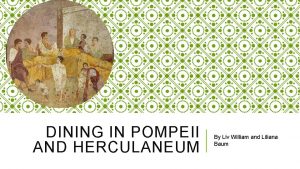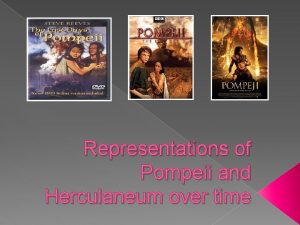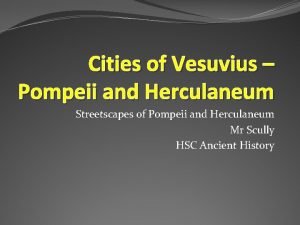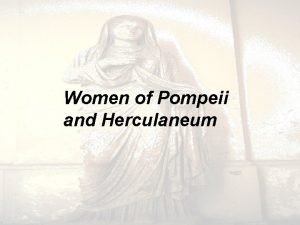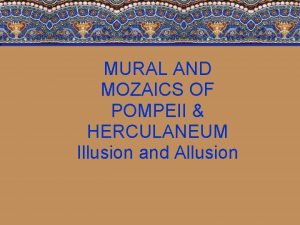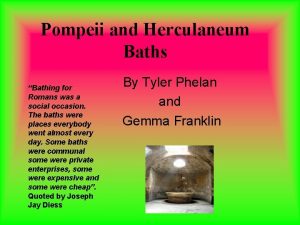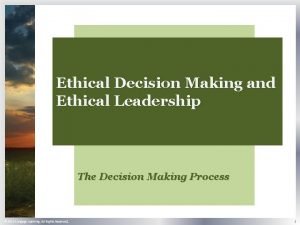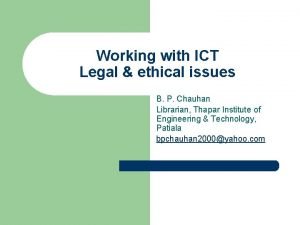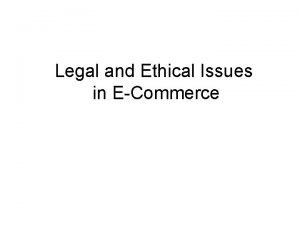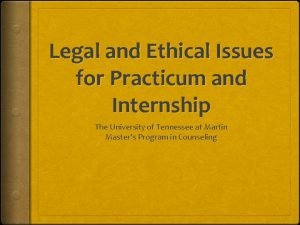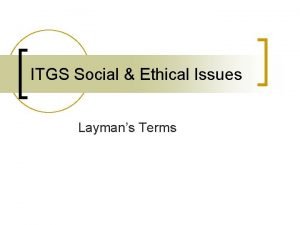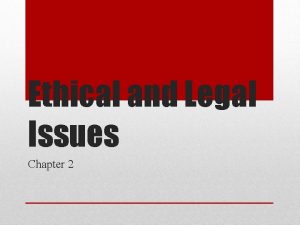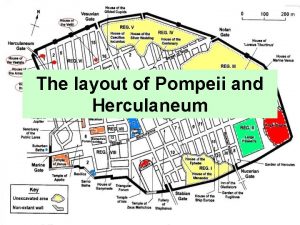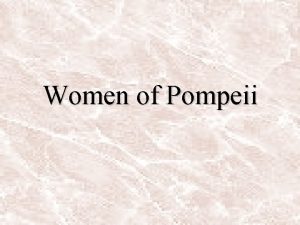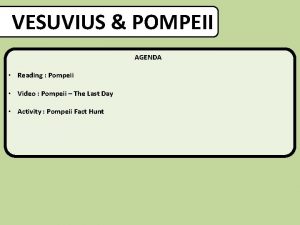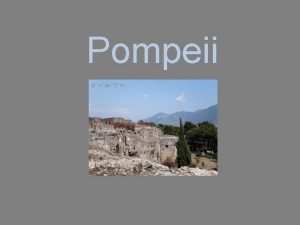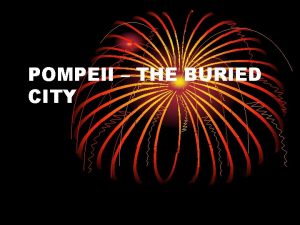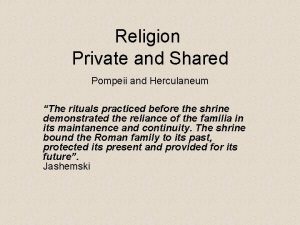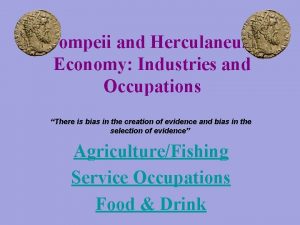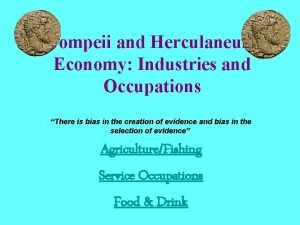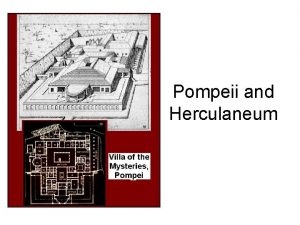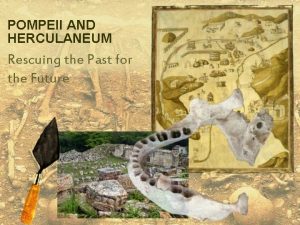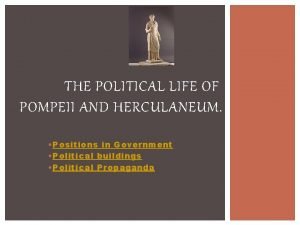ETHICAL ISSUES IN POMPEII AND HERCULANEUM QUESTIONS OF


















- Slides: 18

ETHICAL ISSUES IN POMPEII AND HERCULANEUM

QUESTIONS OF ETHICS � STUDY AND DISPLAY OF HUMAN REMAINS

PROFESSIONAL ETHICS � What are Ethics? � The values by which humans live in relation to other humans. � What are Professional ethics? � These are the norms, standards and values of specific professions.

Respect for the dead � � � Historically, dominant religious groups have special regard for the bodies of the dead. Christians honour the dead and the places where they rest because the body is regarded as the ‘ temple of the Holy Spirit” which will rise again on the last day. For much of the excavation history of Pompeii , tourists morbid fascination with the dead was fed by gruesome and bizarre constructed scenes with skeletons as props. Even today, human remains are an attractive draw card for tourists in museums. During the first half of the twentieth century, the value of skeletons for providing evidence of age , sex and ethnic background grew. As technology has advanced, MRI’S and DNA techniques have revolutionised the amount of information that can be revealed from a body The conflict between cultural and religious sensitivities and scientific need remains one of the strongest ethical dilemmas for the archaeologist Museum ethical principles state that museums have a duty to acquire, preserve and promote their collections as a contribution to safeguarding the cultural and scientific heritage

HISTORICALLY HUMAN REMAINS FROM POMPEII AND HERCULANEUM Since the commencement of excavation human reains have been viewed, firstly as objects for display and more recently as resources for research. The plaster casts from Pompeii have been a unique way of preserving the remains, and they have remained a major drawcard for tourists. On occasions, skeletal elements have been souveenired. The novelist Bulwer Lytton, kept a skull acquired from his visit as a paperweight. � Skeletons and casts have been displayed in Pompeii either in the houses in which they were found or in other protected buildings. Some have been displayed in museums, most recently in travelling exhibitions. � The discoveries of human remains in boathouses over the last decades have raised concerns about research and display. � In more recent years the problem has been addressed by the use of casts, used to create replicas of human remains, which can be displayed on site, while the original material Can be studied and stored appropriately. �

CONFLICTS ARCHAEOLOGY CONSERVATION Gaining information from the object Preserving the object

VERMILLION ACCORD ON HUMAN REMAINS � � � � The Vermillion Accord was adopted in 1989 at the South Dakota WAC Inter. Congress. 1. Respect for the mortal remains of the dead shall be accorded to all, irrespective of origin, race, religion, nationality, custom and tradition. 2. Respect for the wishes of the dead concerning disposition shall be accorded whenever possible, reasonable and lawful, when they are known or can be reasonably inferred. 3. Respect for the wishes of the local community and of relatives or guardians of the dead shall be accorded whenever possible, reasonable and lawful. 4. Respect for the scientific research value of skeletal, mummified and other human remains (including fossil hominids) shall be accorded when such value is demonstrated to exist. 5. Agreement on the disposition of fossil, skeletal, mummified and other remains shall be reached by negotiation on the basis of mutual respect for the legitimate concerns of communities for the proper disposition of their ancestors, as well as the legitimate concerns of science and education. 6. The express recognition that the concerns of various ethnic groups, as well as those of science are legitimate and to be respected, will permit acceptable agreements to be reached and honoured.

ICOM Code of Ethics 2006 ( Museums) � Human remains and materials of sacred significance must be displayed in a manner consistent with professional standards and, where known, taking into account the interests and beliefs of members of the community, ethnic or religious groups from whom the objects originated. They must be presented with great tact and respect for the feelings of human dignity held by all peoples.

What knowledge have human remains yielded? Cause of death Demographic profiles epidemiological characteristics

Sarah Bisel’s findings The mean height for females was 155 cm and 169 cm for men � Sarah collected bone samples to test for the presence of calcium, magnesium, strontium and zinc. She believed that the strontium /calcium ratio showed the proportion of animal to vegetable protein eaten during life. � She concluded that most people in Herculaneum did not rely on red meat, rather they ate a diet rich in vegetables and seafood. There appeared no class distinction. �

Luigi Capasso 1992 � � � � Luigi Capasso worked on 162 skeletons found at Herculaneum. His findings showed : Presence of tuberculosis and brucellosis from milk products made from infected animals. At least 1 out of every 5 people had lice. 11% of the skeletons exhibit signs consistent with individuals having respiratory problems in life which could be caused by the pollution present in Herculaneum. Signs of occupational stress. Evidence that food was contaminated (eg salmonella) Evidence of pleurisy in some bodies. Pleurisy is the inflammation of the lining of the lungs which could then lead to respiratory problems.

ESTELLE LASER � � � � Estelle Lazer worked on over 300 disarticulated bodies as mostly concentrated on skulls, teeth, pelvis, leg and arm remains. Studies of teeth showed an overall bad dental health for the citizens of Pompeii. These included cavities, gum disease, early tooth loss and thick deposits of calcified plaque. This however could tell historians nothing of a persons status in society. The study of teeth also showed Lazer the Pompeian staple food. They ate bread mostly, made from flour impregnated with tiny fragments from lava millstones. Other than this Lazer’s studies showed : 10% of the skulls founds revealed a post-menopausal syndrome called hyperostasis frontanis internia which resulted in obesity and tumours inside the skull which leads to severe headaches and the growth of facial hair. ( Fat Hairy Women of Pompeii) Other skulls showed signs of past surgery and bone fractures. However the study confirmed that generally the population of Pompeii was well nourished and in good health.

Skeletal Material from The House of Julius Polybius 19661996 13 individuals were re-assembled and identified. � There were 3 adult males, 3 adult females of various ages, 4 boys, 1 girl, 1 child of unknown sex and one foetus in the last month of intrauterine life. The foetus was associated with the skeleton of a young (16 -18 years) female whose bones are stained green-blue-black, probably by the jewellery or costume. � It seems that the group is representative of a Pompeian household: many children born approximately 3 years apart, early age at marriage, good food, relative freedom from disfiguring diseases �

Skeletons in the cellar. Dr Fabian Kanz The skeletons of a pair of twins show what were almost certainly the signs of congenital syphilis. If that is correct, then it puts paid to the usual idea that the disease was brought back to Europe from the New World by Christopher Columbus and his sailors in the 15 th Century � The simple fact that they survived shows something about the support networks of the Roman world. There were families who were willing and able to devote time, attention and skill to looking after a pair of very sick offspring �

STORAGE OF ARTEFACTS This plaster cast is of a muleteer who ETHICAL ISSUES? died near the Palaestra Pompeii. The remains of his mule were found nearby. He seems oddly out of place among the amphorae and other objects retrieved from the excavation. The human body, alive or dead, has a moral value, " Anatomist Frank Ruhli

“Without informed consent” Soren Holm is a philosopher and bioethicist based at the University of Manchester, UK, and editor-in-chief of the Journal of Medical Ethics. He says that there are situations where the rights of the dead themselves should be taken into account. For him the important factor is whether a person is identifiable, and therefore still has a reputation that can be damaged.

The Future � One argument for continued access is that with improvements in technology eg MRI, Lazer technology, DNA , that more information can be obtained from skeletal remains � To date Italy does not have a problem with the use of skeletons for research or display

STUDENT ACTIVITY � Using sources 5 and six and other sources evaluate the ethical issues arising from the study and display of human remains at Pompeii and Herculaneum
 Food and dining in pompeii and herculaneum
Food and dining in pompeii and herculaneum Pompeii logo
Pompeii logo Pompeii and herculaneum hsc
Pompeii and herculaneum hsc Pompeii and herculaneum source booklet
Pompeii and herculaneum source booklet The writer properly quotes and cited sources in some places
The writer properly quotes and cited sources in some places State legal, ethical and professional aspects of security.
State legal, ethical and professional aspects of security. Mamia pompeii
Mamia pompeii Herculaneum
Herculaneum Roman baths in pompeii
Roman baths in pompeii Public buildings in pompeii
Public buildings in pompeii Ethical decision making and ethical leadership
Ethical decision making and ethical leadership Legal issues of ict in education
Legal issues of ict in education Legal and ethical issues in ecommerce
Legal and ethical issues in ecommerce Legal and ethical issues in computer security
Legal and ethical issues in computer security Ethical and legal issues involved in practicum
Ethical and legal issues involved in practicum Social ethical issues itgs
Social ethical issues itgs Accounting ethical issues
Accounting ethical issues Social and ethical issues in information systems
Social and ethical issues in information systems Chapter 2 ethical and legal issues
Chapter 2 ethical and legal issues
